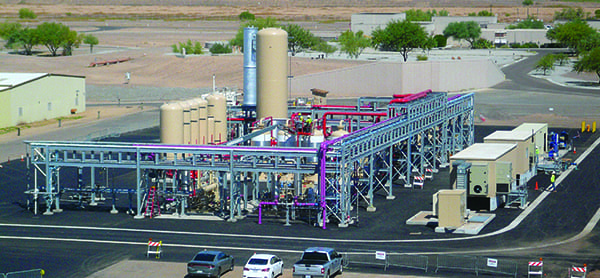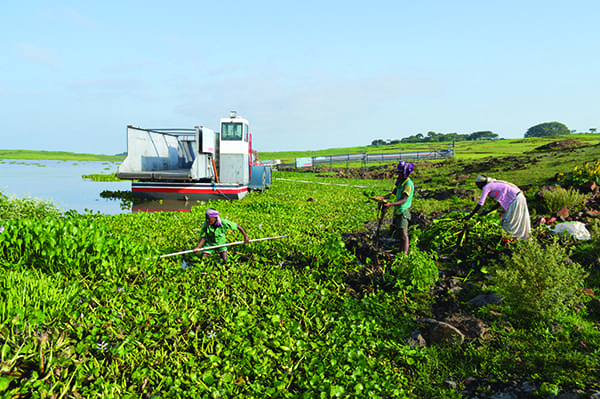Is Biomass Dead?
Credit to Author: POWER| Date: Mon, 03 Feb 2020 05:29:48 +0000
The post Is Biomass Dead? appeared first on POWER Magazine.
With subsidies running short and emissions regulations still a challenge, the promise of biomass as a sustainable source for utility-scale power generation remains elusive. Yet, there are novel applications keeping the industry alive.
The Covanta Biomass Plant, just south of Delano, California, was once a crown jewel for the prospect of sustainable energy in California. The 50-MW plant once employed 50 people and was all the rage during a time of hope that biomass might be a prosperous sustainable energy source.
Today, its structures are rusting and vegetation grows where it shouldn’t. What was once a sprawling industrial facility, with many moving parts and people, is now a ghost town, an abandoned plant, resonating with a message that biomass power is simply not what it was hoped to be.
The plant operated from 1990 until 2015, and burned agricultural waste such as uprooted trees and pruned branches from nearby almond, peach, and nectarine orchards. But along came subsidies for energy sources such as solar, wind, and other sustainable power options, and the plant fell into demise. Other plants have taken the same route. And more will likely shut down in the near future.
Dependence on subsidies, emissions problems, and other issues, have put utility-scale biomass on the decline. The viability of biomass as a fuel is dubious, and it’s not competing well with other fuel sources. For specific applications, however, biomass and other waste products, such as biomethane, may be useful.
Biomass and Waste as Fuel: Prevalent but Slowing
“By providing an alternative source of energy from a renewable domestic resource, existing biomass energy facilities diversify the nation’s energy portfolio, which can help our utilities weather unexpected changes in the price or availability of other resources,” said Mack McGuffey, an environment attorney and partner with Troutman Sanders LLP in Atlanta, Georgia. “However, so long as natural gas remains at historically low levels, the demand for electricity remains flat, and the controversy regarding the ‘carbon-neutral’ nature of biomass remains unresolved, the interest and investment in new biomass energy facilities is likely to be low.”
According to the U.S. Energy Information Administration (EIA), in 2018 there were 178 biomass power generating facilities in the U.S., with a total capacity of 6,374 MW of power. The EIA says, “electricity generation from biomass and waste is a diverse collection of organic feedstocks including wood and wood waste solids, black liquor [a byproduct of making wood pulp], municipal solid waste, and landfill gas. These four feedstocks accounted for more than 94% of biomass and waste electricity generation in 2018.” But the amount of biomass, relative to other fuel sources, was very small.
Things are slowing for biomass. In the same report, the EIA says that electricity generated from biomass and waste totaled 70.6 million MWh in 2018, or about 2% of total U.S. electricity generation. “Expansion in electricity generation from biomass and waste has ended in recent years, after growing from 2004 through 2014, and in 2018 was 2% below its peak generation of 71.7 million MWh in 2014.”
Behind the Downtrend of Utility-Scale Biomass Power
The expectation of biomass as a fuel source for large-scale power plants started strong about a decade or longer ago, but has struggled to show its full value. The Wall Street Journal said in 2009: “While solar power is taking root in the sunny Southwest and wind power is growing in the blustery band from the Dakotas to Texas, other places are turning to trees and grass as their best bet for producing renewable energy, leading to a new building boom in ‘biomass’ power plants.”
Ten years later, the same newspaper reported: “An industry considered sustainable today can seem nefarious tomorrow—just look at biomass.” It cited the expected returns of firms in the biomass power generation business, such as Covanta, Southern Company, Dominion Energy, and Pacific Ethanol, who entered the industry with a prosperous return on investment, but after a decade, such returns are lost. Much has to do with the emissions of biomass combustion.
“Though one can never completely separate the regulatory from the economics in power, the economics by themselves are challenging for biomass,” said Penn Cox, who held top leadership posts at Ferrovial and Rollcast Energy, a biomass development company that developed several projects. “Assuming good waste wood procurement, a new plant in the Southeast will have a fuel cost of about $25 per MWh. That is fuel alone—it doesn’t include O&M [operation and maintenance] costs, debt service, return to investors, et cetera. Older plants and plants in the Northeast or Upper Midwest will have higher prices. That compares quite favorably to coal, depending on the source and transportation costs, but is not very competitive with GTCC [gas turbine combined cycle], which would be around $20 per MWh and has lower O&M and capital costs. Recently, solar developers are bidding into RFPs [requests for proposals] for utility-scale solar with leveled, all-in prices of less than $30 per MWh, so times are tough for thermal power, especially solid fuel. Biomass is not alone.”
Cox illustrated the tough times for biomass by looking at the state of New Hampshire. Its six biomass plants have been around since the 1980s, “but have struggled to remain operational over the last several years,” explained Cox. “The legislature passed a bill earlier this year that would require utilities in the state to purchase a certain amount of biomass power to support the plants.”
Specifically, New Hampshire House Bill 183 would have created one “Baseload Renewable Generation Credit” for each net MWh of production from eligible facilities. The state’s electric distribution companies would have been required to purchase all the credits offered and produced by the plants located in their service territories. “The bill was ultimately vetoed by the governor,” said Penn Cox. An attempt to override the veto came up four votes short.
Cox also cited the example of the Nacogdoches biomass facility in East Texas. That plant—originally owned by Southern Power—sold its generation under a power purchase agreement (PPA) with Austin Energy. “It opened in 2012 and is the largest biomass facility in the U.S., so it is very efficient and is in a very attractive wood basket,” explained Cox. “Unfortunately, because of low gas prices, and cheap wind and solar, the plant rarely dispatched in the ERCOT [Electric Reliability Council of Texas] market. Even though the plant did not dispatch, the terms of the PPA required Austin Energy to make capacity and O&M payments that would essentially keep the owner whole. Austin Energy recently purchased the plant from Southern to avoid continuing to pay out on the PPA.”
Biomass and Waste Still Viable and Promising in Some Applications
Slow expansion, however, does not mean it, or other fuel sources like it, are dead and gone. Opportunity exists, not just in biomass, but also as the EIA statistics point out, with waste products.
 |
1. Using innovative technology, Ameresco processes raw biogas generated at the 91st Avenue Wastewater Treatment Plant in Phoenix, Arizona, into renewable natural gas suitable for injection into the nation’s high-pressure natural gas pipeline. Courtesy: Ameresco |
Ameresco’s 91st Avenue Wastewater Treatment Plant (Figure 1) in Phoenix, Arizona, is purifying organic waste materials into biomethane, or renewable natural gas (RNG). The RNG is then used as a fuel source for renewable electric power generation.
RNG is an ultra-clean and ultra-low-carbon natural gas alternative. As organic waste breaks down, it emits methane gas that would otherwise be released into the atmosphere. Now, it may be purified and used as an alternative renewable energy source.
“A significant amount of power is produced by biomethane power generation,” explained Michael T. Bakas, executive vice president, Distributed Energy Systems, with Framingham, Massachusetts-based Ameresco. The firm partnered with the City of Phoenix to establish the biomethane plant. “Biomethane that is used at power plants makes up 20% to 25% of the biomethane in North America. The RNG generated at the 91st Avenue Wastewater Treatment Plant was a wasted resource that represented an opportunity for the City of Phoenix to not only make a powerful statement about its commitment to the environment and sustainability, but to also reap significant financial benefits,” said Bakas.
In other applications, biomass as an energy source may help solve two challenges: it mitigates environmental problems and can be burned with very low oxygen to produce biochar. Farmers use biochar to enhance and improve soil quality. Furthermore, the biochar captures carbon and is a promising source of carbon sequestration.
That’s the case with Lake Tana, in Shea Gomengie, Ethiopia. The lake is the largest lake in Ethiopia (52 miles long by 42 miles wide), supplies nearly half the nation’s fresh water, and it’s full of serene green water hyacinths with pretty lavender-colored blooms. In spite of such beauty, the plants are a menacing vegetation and a dangerous weed.
“It deprives fish and plants of nutrients and poisons the atmosphere with methane,” said Olivia Thierley of the German-based Char2Cool, operating in Ethiopia. “It brings hydroelectric plants and the drinking water supply to a halt.”
 |
2. Water hyacinth is a big problem at Lake Tana in Ethiopia. However, the invasive vegetation can be harvested and biochar made through pyrolysis, which is the thermal decomposition, in a limited-oxygen environment, of biomass into a carbon-rich solid residue (char), gases, and liquids. Courtesy: Char2Cool |
Char2Cool has found a solution. It uses large waterborne machinery to harvest the water hyacinths (Figure 2) and turn the unwanted vegetation into treasure: biochar. By cultivating the biomass, it’s producing a CO 2 -negative fuel. “Now, it becomes a major opportunity,” Thierley said.
Opportunity Remains
If, as baseball legend Yogi Berra said, “It ain’t over, ‘til it’s over,” then biomass still remains as a workable fuel source for sustainable power in many ways. It remains as a fuel source and biomass plants still operate. In order for it to regain a second wind, though, it will need to continually overcome challenges.
“From an environmental perspective, biomass energy faces greater challenges than other renewable resources due to the ongoing controversy surrounding the question of whether CO 2 emitted from combusting biomass is—or always is—‘carbon neutral,’ ” said McGuffey. “[The U.S. Environmental Protection Agency] has made several attempts to craft a policy regarding the carbon-neutral nature of biomass without success, but a new proposal is expected in March 2020. Despite these challenges, several companies remain active in biomass energy, and there are many utility-scale biomass energy facilities in operation throughout the U.S.”
While the biomass bonanza from plants like Covanta’s in California may be dead, byproducts such as biomethane, and other applications such as the utilization of biomass vegetation to create biochar—as in the harvest of water hyacinths from Lake Tana in Ethiopia—do show promise in more selective operations. It is also used for smaller-scale, off-grid applications, such as a farm in Canada that cultivates willow trees and growth around a wetlands area, converting it into a fuel to be used for farm property use.
Biomass awaits new opportunities, new exploitation, and new ventures to serve world sustainable energy markets for today and tomorrow. As the futurist, Buckminster Fuller, who lived nearly nine decades and saw America expand from an agricultural to an industrial nation, said, “Pollution is nothing but resources we’re not harvesting. We allow them to disperse because we’ve been ignorant of their value.” ■
—Jim Romeo (www.JimRomeo.net) is a technology writer and speaker.
The post Is Biomass Dead? appeared first on POWER Magazine.